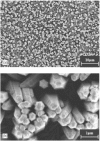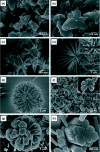Hydrothermal growth of ZnO nanostructures
- PMID: 27877250
- PMCID: PMC5109597
- DOI: 10.1088/1468-6996/10/1/013001
Hydrothermal growth of ZnO nanostructures
Abstract
One-dimensional nanostructures exhibit interesting electronic and optical properties due to their low dimensionality leading to quantum confinement effects. ZnO has received lot of attention as a nanostructured material because of unique properties rendering it suitable for various applications. Amongst the different methods of synthesis of ZnO nanostructures, the hydrothermal method is attractive for its simplicity and environment friendly conditions. This review summarizes the conditions leading to the growth of different ZnO nanostructures using hydrothermal technique. Doping of ZnO nanostructures through hydrothermal method are also highlighted.
Keywords: ZnO; doping; hydrothermal; nanostructures; synthesis.
Figures





















References
-
- Emanetoglu N W, Gorla C, Liu Y, Liang S. and Lu Y. Mater. Sci. Semicond. Process. 1999;2:247. doi: 10.1016/S1369-8001(99)00022-0. - DOI
-
- Chen Y, Bagnall D and Yao T. 2000. Mater. Sci. Eng. B 75 190 10.1016/S0921-5107(00)00372-X - DOI
-
- Liang S, Sheng H, Liu Y, Hio Z, Lu Y. and Chen H. J. Cryst. Growth. 2001;225:110. doi: 10.1016/S0022-0248(01)00830-2. - DOI
-
- Lee J Y, Choi Y S, Kim J H, Park M O. and Im S. Thin Solid Films. 2002;403:533. doi: 10.1016/S0040-6090(01)01550-4. - DOI
Publication types
LinkOut - more resources
Full Text Sources
Other Literature Sources
